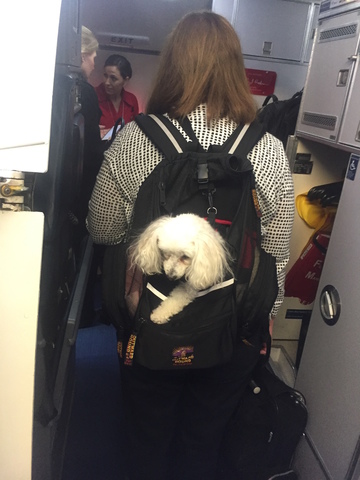What is up with people bringing their dogs to the grocery store or on an airplane?
Sure, real service dogs are one thing but police in several cities say they are seeing people claiming their pets are service animals even when they aren’t.
Send photos of aggressive fake service dogs that you’ve seen to investigative reporter Jace Larson at jace.larson@scripps.com or by text at 720-270-1468.
“We are certainly seeing an increase of people misrepresenting their pet as a service animal,” City of Boulder, Colorado’s Animal Control Supervisor Janee Boswell said. Boswell is also president of the statewide group Colorado Animal Control Officers.
A fake service dog attacked 8-year-old Jack Thatcher while he was eating at a cafe and left a significant bruise on his leg, in the Denver suburb two years ago.
“I passed the dog for no reason at all and it just jumped up and bit me on the lower leg,” Thatcher said.

Investigators later discovered the woman who brought the dog to the cafe had been questioned by staff who were concerned the dog might not have been a service animal.
“She lied about having the dog at the restaurant because she wanted to sit and have lunch with her friends. She said it was a service animal. She didn’t have a disability nor was the dog trained in any capacity as a service animal,” Boswell told Larson.

EMOTIONAL SUPPORT VS SERVICE DOGS
You might be surprised to learn there is no federal government registration for service animals. People don’t need a doctor’s note to have a service dog or to bring it with them to the grocery store or on an airplane.
Federal law only says you must have a disability and your dog must be trained to perform a related task.
Service animals can go almost anywhere. Service animals are not allowed in sterile areas of a hospital, for example.

Emotional support dogs are different. They make a person feel better and the law says they’re allowed in places of housing and on airplanes. The housing allowance means you can have an emotional support dog, in many cases, even if you live in an apartment complex that doesn’t allow pets.
Caitlin Brady, who is in a wheelchair, recently had a dog lunge after her trained service dog while she was on a flight.
“Everybody was getting out of the plane,” Brady said. “She lunged at my dog, barking and snapping.”
Brady said she worried about the safety of her service dog.

Real service dogs cost more than $10,000. Some types of service dogs cost even more. A seeing-eye dog for a blind person can cost as much as $25,000, service dog trainer Barbara Henry said.
She is frustrated by fake service dogs because she feels it endangers people with real disabilities.
“Last summer I had to hunt down a grocery store manager. There was a dog in a grocery cart on its dog bed. Its dog bed was absolutely filthy,” she said. “When disabled people go out to do their grocery shopping and they encounter a service or a dog in a vest that is not appropriately behaved, sometimes aggressive, they don’t get their groceries because they are not going to risk running their expensive, well trained, service dog.”
SAY SOMETHING
Some grocery store chains such as King Soopers and Kroger have trained employees on how to handle customers who claim their pets are service animals, if an animal is acting oddly.
Henry wants more members of the public to speak up to flight attendants or store managers if you see a dog that appears not to be a service animal.
Henry says a trained service animal will not usually get agitated. Trained service dogs will stay clam, even in loud, uncertain circumstances, she says.
Dogs who aren’t trained as service animals may pant excessively in average-temperature situations. They might look around constantly and appear unrelaxed, Henry said.

Jace Larson is an award-winning investigative reporter for The Now. If you have a story idea or a tip for Jace, email or text him at jace@thedenverchannel.com or 720-270-1468. You can remain anonymous. Connect with Jace on Facebook, Twitter or Instagram.



